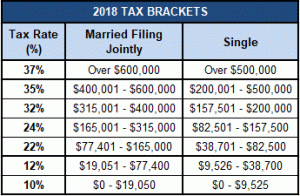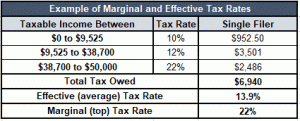What’s the Difference Between Marginal and Effective Tax Rates?
Apr 12, 2018 • Written by Paul Staib | Certified Financial Planner (CFP®), MBA, RICP®
Blog Home » Financial Planning » What’s the Difference Between Marginal and Effective Tax Rates?

In order to explain the difference between “marginal” and “effective” tax rates, it’s important to first dispel a common misconception: All of the income you make is not taxed at one rate. For example, let’s say you are a single filer who makes $50,000 per year, which in 2018 puts you in the 22% tax bracket. If you paid tax at a flat 22% rate on your income, you would owe $11,000. But if you look up $50,000 in the IRS’ 2018 1040 Tax Tables, you’ll find that you owe less than that – you owe $6,940. Why is that?
The most straightforward way to explain it is this: You pay taxes in tiers. You are taxed at a 10% rate on the first $9,525 of your income, which is the upper boundary of the 10% tax bracket. The next $29,175 of your income – the amount from $9,525 to $38,700, or the 12% bracket – of your income will be taxed at 12%. The next bracket, 22%, goes from $38,700 in earned income to $82,500. This is the final strata of your income because your taxable income doesn’t reach the upper bound of the 22% bracket, which is $82,500. Therefore, you will be taxed 22% only on the amount of your income that exceeds $38,700 (the upper limit of the 12% tax bracket) up to $50,000 (your income). In other words, $11,300 of your income is subject to the 22% tax rate.
In this case, 22% is your marginal tax rate. You can think of your marginal tax rate as the tax rate that applies only to the last dollars you make over the course of the tax year. The effective tax rate, meanwhile, represents the average tax rate you pay on all the money you make during the year.
Calculating the Difference
To illustrate how marginal and effective tax rates differ, let’s first look at the marginal tax rates for the 2018 tax year.
Using the above tax brackets, let’s look at how marginal and effective rates come into play. For our example, we’ll continue to use a single taxpayer with $50,000 in taxable income. Here’s how that $50,000 would break down in terms of the applicable tax brackets.
So, as a taxpayer the marginal tax rate – what you pay at the top end of your taxable income – differs quite a bit from what you pay as an overall average tax rate on your income. Why do we hear so much about marginal income tax rates when effective income tax rates are arguably more important?
There are a few reasons. For one, political debates over income taxes often center on marginal rates. A result of recent debate was the Tax Cuts and Jobs Act, which kept the seven tax brackets but modified the tax rates and the size of the brackets.
When Marginal Rates Matter
The more important reason that marginal rates matter, though, is they can factor into certain tax-management decisions. For example, let’s say a taxpayer is considering whether to contribute to a traditional IRA, in which contributions are tax deductible, or a Roth IRA, in which contributions are not deductible but qualified withdrawals are tax-free (qualified withdrawals from a traditional IRA are taxed). Since a contribution to a traditional IRA lowers the investor’s overall taxable income, the deduction is typically calculated based on the investor’s marginal tax rate – that is, the rate paid on his or her last dollar of taxable income for the year. If the investor contributes $5,500 to a traditional IRA for the year and falls in the 22% marginal tax bracket, the deduction on the contribution can be said to be worth a tax savings of $1,210 ($5,500 times 0.22).
Conventional wisdom says that if one expects his or her marginal rate to go down in retirement, the traditional deductible retirement account is preferable, while if he or she expects it to go up, the Roth is better. If the individual expects his or her marginal rate to remain the same in retirement, one could argue for either the traditional account or the Roth.
Marginal tax rates also play a role when considering other types of tax breaks as well. For those who choose to itemize rather than take the standard deduction, deductions that reduce the taxpayer’s taxable income – such as mortgage interest, state and local property taxes, and charitable donations – represent a savings applied against the marginal rate. For someone with a marginal tax rate of 32% who paid $10,000 in mortgage interest last year, that deduction is worth $3,200 ($10,000 times 0.32). With enough deductions, that taxpayer could even fall into a lower marginal tax bracket (although taking too many deductions can subject taxpayers to the dreaded alternative minimum tax).
It should also be noted that as a result of the Jobs and Tax Cuts Act, several rules regarding itemized deductions are changing beginning with the 2018 tax year (the return taxpayers will file in April 2019). In 2018, standard deductions are increasing in a big way – to $12,000 for individuals and $24,000 for married couples filing jointly from $6,350 and $12,700, respectively. Those higher standard deduction amounts will likely lead to a reduction in the number of taxpayers who itemize their deductions rather than claiming a standard deduction. In addition, Congress has put limits on up some the big-ticket deductions many taxpayers had been able to use in the past; as a result, those below-the line deductions reported on Schedule A will be less beneficial for many taxpayers.
Calculating Your Effective and Marginal Rates
While the marginal tax rate focuses on what happens at the top of your taxable income amount, it’s your effective tax rate that is typically more meaningful. After all, it’s what you pay on all of your income combined that matters, not just the portion near the top.
Calculating your marginal federal income tax rate is pretty straightforward – use the tables above to see where your taxable income falls within the brackets. To calculate your effective federal income tax rate, look at line 63 of your 1040 form to find your total tax. Divide this amount by your taxable income, found on line 43. Multiply the number by 100, and you get your effective tax rate. (This method looks at your tax rate on income after deductions and exemptions are applied; but if you wanted to use your income before these are taken out, you could instead use your adjusted gross income, found on line 37 of the 1040.)
If you also pay state or local income tax, you can do a similar calculation using the relevant numbers.

Paul Staib | Certified Financial Planner (CFP®), MBA, RICP®
Paul Staib, Certified Financial Planner (CFP®), RICP®, is an independent Flat Fee-Only financial planner. Staib Financial Planning, LLC provides comprehensive financial planning, retirement planning, and investment management services to help clients in all financial situations achieve their personal financial goals. Staib Financial Planning, LLC serves clients as a fiduciary and never earns a commission of any kind. Our offices are located in the south Denver metro area, enabling us to conveniently serve clients in Highlands Ranch, Littleton, Lone Tree, Aurora, Parker, Denver Tech Center, Centennial, Castle Pines and surrounding communities. We also offer our services virtually.
Read Next
Investment Strategy…using an Index Card
• Written By Paul Staib | Certified Financial Planner (CFP®), MBA, RICP®
Harold Pollack, a professor of public policy at the University of Chicago, generated a good deal of buzz a few…
When It Pays to Retire With a Mortgage
• Written By Paul Staib | Certified Financial Planner (CFP®), MBA, RICP®
Sometimes retiring with a home you own free and clear isn’t the best choice. If you’re in or near retirement…


